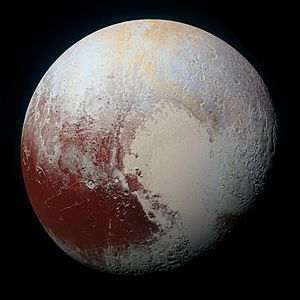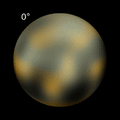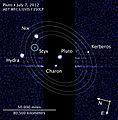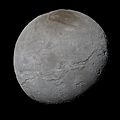Pluto facts for kids

|
|||||||||
| Discovery | |||||||||
|---|---|---|---|---|---|---|---|---|---|
| Discovered by | Clyde W. Tombaugh | ||||||||
| Discovery date | February 18, 1930 | ||||||||
| Designations | |||||||||
| MPC designation | 134340 Pluto | ||||||||
| dwarf planet, TNO, plutoid, KBO, plutino |
|||||||||
| Adjectives | Plutonian | ||||||||
| Orbital characteristics | |||||||||
| Epoch J2000 | |||||||||
| Aphelion | 7,375,927,931 km 49.305 032 87 AU |
||||||||
| Perihelion | 4,436,824,613 km 29.658 340 67 AU |
||||||||
| 5,906,376,272 km 39.481 686 77 AU |
|||||||||
| Eccentricity | 0.248 807 66 | ||||||||
| 90,613.305 days 248.09 years 14,164.4 Pluto solar days |
|||||||||
| 366.73 days | |||||||||
|
Average orbital speed
|
4.666 km/s | ||||||||
| Inclination | 17.141 75° 11.88° to Sun's equator |
||||||||
| 110.303 47° | |||||||||
| 113.763 29° | |||||||||
| Known satellites | 5 | ||||||||
| Physical characteristics | |||||||||
|
Mean radius
|
1,187 ± 4 km 0.18 Earths |
||||||||
| 1.665×107 km² 0.033 Earths |
|||||||||
| Volume | 6,39×109 km³ 0.0059 Earths |
||||||||
| Mass | (1.305 ± 0.007)×1022 kg 0.002 1 Earths 0.178 moon |
||||||||
|
Mean density
|
2.03 ± 0.06 g/cm³ | ||||||||
| 0.658 m/s² 0.067 g |
|||||||||
| 1.229 km/s | |||||||||
|
Sidereal rotation period
|
−6.387 230 day 6 d 9 h 17 m 36 s |
||||||||
|
Equatorial rotation velocity
|
47.18 km/h | ||||||||
| 119.591 ± 0.014° (to orbit) | |||||||||
|
North pole right ascension
|
133.046 ± 0.014° | ||||||||
|
North pole declination
|
−6.145 ± 0.014° | ||||||||
| Albedo | 0.49–0.66 (varies by 35%) | ||||||||
|
|||||||||
| up to 13.65 (mean is 15.1) | |||||||||
| −0.7 | |||||||||
| Atmosphere | |||||||||
|
Surface pressure
|
0.30 Pa (summer maximum) | ||||||||
| Composition by volume | nitrogen, methane, carbon monoxide | ||||||||
Pluto is a dwarf planet located in our Solar System. Its official name is 134340 Pluto. This dwarf planet is the ninth largest object that orbits the Sun. For a long time, Pluto was considered the ninth planet. Now, it is known as the biggest object in the Kuiper belt.
Like other objects in the Kuiper belt, Pluto is mostly made of rock and ice. It is quite small. It weighs about one-fifth (⅕) of the Earth's Moon. Its size is only about one-third (⅓) of the Moon's volume. Pluto is very far from the Sun, so it is extremely cold. The average temperature on Pluto is about -223 degrees Celsius.
Pluto has a very unusual orbit that is also highly tilted. It travels between 30 and 49 AU (4.4–7.4 billion km) from the Sun. Because of this, Pluto sometimes gets closer to the Sun than Neptune.
Pluto was discovered in 1930 and was thought to be the Solar System's ninth planet. In the late 1970s, scientists learned that Pluto was quite small. Later, in the early 2000s, other objects similar to Pluto were found. One of these was Eris.
On August 24, 2006, the International Astronomical Union (IAU) officially defined what a "planet" is. By this new definition, Pluto no longer fit the description of a planet. It was then classified as a "dwarf planet," along with Eris and Ceres. After this, Pluto was given the number 134340 and added to the list of minor planets. However, some scientists still believe Pluto should be called a planet.
Contents
How Was Pluto Discovered?
In the 1840s, a scientist named Urbain Le Verrier used math to predict that the planet Neptune existed. He figured this out by studying the orbit of Uranus. After Neptune was found, astronomers thought another planet might be affecting Uranus's orbit.
In 1906, Percival Lowell from Boston started a big search for this ninth planet. He called it "Planet X." Lowell continued his search until 1916, but he didn't find anything. Interestingly, his observatory had actually taken two pictures of Pluto on March 19, 1915, but no one realized what they were at the time.
The search for Planet X began again in 1929. The job was given to Clyde Tombaugh, a 23-year-old from Kansas. Tombaugh had just started working at the Lowell Observatory. He was known for his amazing drawings of space.
Tombaugh's task was to take many pictures of the night sky, usually in pairs, every two weeks. Then, he would compare each pair to see if any object had moved. He used a special machine called a blink comparator. This machine helped him quickly switch between the two pictures. If an object had changed its spot, he could easily see it "blink."
On February 18, 1930, Tombaugh found an object that seemed to move in pictures taken on January 23 and January 29. Another picture from January 21 confirmed his discovery. After the observatory did more checks, the news was sent out on March 13, 1930.
How Did Pluto Get Its Name?
The discovery of Pluto was big news around the world. The Lowell Observatory had the right to name the new object. They received over 1000 name ideas from people everywhere.
The name Pluto was suggested by Venetia Burney, an 11-year-old schoolgirl from Oxford, England. Venetia was interested in classical mythology and space. She thought the name of the Roman god of the underworld would be perfect for a dark and cold world far away. She suggested it to her grandfather, Falconer Madan, who then passed the idea to astronomers in the United States.
The new object was officially named on March 24, 1930. The Lowell Observatory staff voted on three names: Minerva, Cronus, and Pluto. Pluto received all the votes. The name was announced on May 1, 1930. As a reward, Venetia received five pounds from her grandfather.
The name Pluto became very popular. The Disney character, Pluto the dog, was introduced in the same year and named after the dwarf planet. In 1941, scientist Glenn T. Seaborg named the new element plutonium after Pluto. This followed a tradition of naming new elements after planets, like uranium (after Uranus) and neptunium (after Neptune).
Why Is Pluto a Dwarf Planet?
In August 2006, the International Astronomical Union (IAU) created a clear definition for what a "planet" is. For an object in our Solar System to be called a planet, it must meet three conditions:
- It must orbit around the Sun.
- It must be big enough for its own gravity to pull it into a round shape.
- It must have cleared its orbit of other objects. This means it's the main object in its path around the Sun.
Pluto meets the first two conditions. It orbits the Sun and is round. However, it fails the third condition. Pluto's mass is much smaller than the total mass of other objects in its orbit. For example, Earth is 1.7 million times heavier than all other objects in its orbit (not counting the Moon).
The IAU decided that objects like Pluto, which meet the first two conditions but not the third, would be called dwarf planets. In September 2006, Pluto was officially listed in the Minor Planet Catalogue as "(134340) Pluto."
Pluto's Moons
Pluto has five known moons. Its largest moon is called Charon. Sometimes, Pluto and Charon are called a "binary system." This is because their shared center of orbit (called the barycenter) is not inside either of them.
The IAU still classifies Charon as a moon of Pluto. Pluto's four smaller moons are Nix and Hydra, discovered in 2005. Then came Kerberos, found in 2011, and Styx, discovered in 2012.
| The Solar System | |||||||
|---|---|---|---|---|---|---|---|
|
|
|||||||
| Sun • Heliosphere |
Planets ☾ = moon(s) ∅ = rings |
Mercury | Venus | Earth ☾ | Mars ☾ | ||
| Jupiter ☾ ∅ | Saturn ☾ ∅ | Uranus ☾ ∅ | Neptune ☾ ∅ | ||||
| Dwarf planets | Ceres | Pluto ☾ | Haumea ☾ | Makemake | |||
| Eris ☾ | |||||||
| Small Solar System bodies |
Asteroids (minor planets) |
Groups and families: Vulcanoids · Near-Earth asteroids · Asteroid belt Jupiter Trojans · Centaurs · Neptune Trojans · Asteroid moons · Meteoroids · Pallas · Juno · Vesta · Hygiea · Interamnia · Europa |
|||||
| See also the list of asteroids. | |||||||
| Trans- Neptunians |
Kuiper belt – Plutinos: Orcus · Ixion – Cubewanos: Varuna · Quaoar · Huya |
||||||
| Scattered disc: Sedna | |||||||
| Comets | Periodic comets and non-periodic comets Damocloids · Oort cloud |
||||||
| See also the list of solar system objects | |||||||
Images for kids
-
High-resolution MVIC image of Pluto in enhanced color to bring out differences in surface composition
-
Image of Pluto in X-rays by Chandra X-ray Observatory (blue spot). The X-rays are probably created by interaction of the gases surrounding Pluto with solar wind, although details of their origin are not clear.
-
Plot of the known Kuiper belt objects, set against the four giant planets
-
Computer-generated rotating image of Pluto based on observations by the Hubble Space Telescope in 2002–2003
See Also
 In Spanish: Plutón (planeta enano) para niños
In Spanish: Plutón (planeta enano) para niños






















